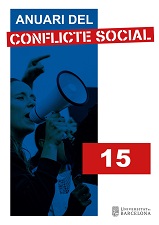Geographies of Mapuche protest during the first year of Boric’sgovernment
DOI:
https://doi.org/10.1344/ACS2024.15.6Keywords:
social movements, mapuche people, repertoire of contention, Geography of conflictAbstract
This paper offers an extended analysis of the conflicts taking place in Mapuche territory in 2022, during the initial year of President Gabriel Boric’s left-leaning administration. By examining various online newspapers, it was found that anti-forestry protests spread from Arauco to Cautín, with a notable focus on Malleco, while anti-colonial protests moved northward from Cautín. The paper also considers several key events, such as the preventive detention of Mapuche leader Héctor Llaitul, the plebiscite for the New Constitution, and government representatives’ visits to Mapuche areas. There are concerns about the possible intensification of a neo-extractivist model under a progressive government which is expected to address the conflict with high hopes for resolution.
References
Bresciani sj, C., Fuenzalida sj, J., Rojas Pedemonte, N., & Soto sj, D. (2018). Mitos chilenos sobre el Pueblo Mapuche. Ediciones Revista Mensaje.
Gálvez, D., & Rojas Pedemonte, N. (2022). La protesta mapuche y la extensión del estado de emergencia en Wallmapu. Anuario Del Conflicto Social, (13), e–41202. https://doi.org/10.1344/ACS2022.13.1
Herrero, V., & Ortiz, D. (11 de Agosto de 2022). Exclusivo: cae jefe de inteligencia de Carabine-ros en Macrozona Sur por posibles nexos con robo de madera. Obtenido de Interferencia: https://interferencia.cl/articulos/exclusivo-cae-jefe-de-inteligencia-de-carabineros-en-macrozona-sur-por-posibles-nexos-con
Instituto Nacional de Derechos Humanos (INDH). (2014). Estado de Chile y pueblo Mapuche: Análisis de tendencias en materia de violencia estatal en la región de La Araucanía. An-dros.
Latorre, J. I., y Rojas Pedemonte, N. (2016). El conflicto forestal en territorio mapuche hoy. Ecolo-gía Política en América Latina (51), 84-87.
Nahuelpán, H., Martínez, E., Hofflinger, Á., y Millalen, P. (14 de Julio de 2021). ¿Para qué se cons-truyó la idea del narcoterrorismo en Wallamapu? Obtenido de Columnas de opinión CI-PER Chile: https://www.ciperchile.cl/2021/07/14/para-que-se-construyo-la-idea-del-narcoterrorismo-en-wallmapu/
Rojas Pedemonte, N., & Miranda, O. (2017). Dinámica sociopolítica del conflicto y la violencia en territorio mapuche. Particularidades históricas de un nuevo ciclo en las relaciones conten-ciosas. Revista De Sociología, (30), 33–69. https://doi.org/10.5354/0719-529X.2015.46411
Rojas Pedemonte, N., & Gálvez, D. (2020). La protesta mapuche como proceso interactivo: espa-cios y dinámicas del conflicto en el retorno de piñera. Anuario del Conflicto Social, (9). https://doi.org/10.1344/ACS2019.9.3
Rojas Pedemonte, N., y Gálvez, D. (2020b) La protesta mapuche más allá -y más acá- del Estallido Social en Chile en "La Resistencia Mapuche y el Estallido Social en Chile. Anuario del conflicto en territorio mapuche, 2019". Revista Mensaje Ediciones.
Sepúlveda, N. (23 de Abril de 2019). Chasts de inteligencia: la red de Carabineros para inculpar a mapuches en tráfico de armas que involucró a agentes argentinos. Obtenido de CIPER Chile: https://www.ciperchile.cl/2019/04/23/chats-de-inteligencia-la-red-de-carabineros-para-inculpar-a-mapuches-en-trafico-de-armas-que-involucro-a-agentes-argentinos/
Svampa, M. (2019). Neo-extractivism in Latin America. Cambridge University Press.
Tarrow, S. (2011). Power in Movement (3rd Ed.). Cambridge University Press.
Tilly, C. (2003). Politics of collective violence. Cambridge University Press.
Torres, R., Azócar, G., Carrasco, N., Zambrano, M., Costa, T., & Bolin, B. (2016). Desarrollo fo-restal, escasez hídrica y la protesta social mapuche por la Justicia Ambiental en Chile. Am-biente & Sociedade, 19(41), 121-146.
Warnecke-Berger, H., Burchardt, H.-J., & Dietz, K. (2023). The failure of (neo-) extractivism in Latin America – explanations and future challenges. Third World Quarterly, 44(8), 1825-1843. https://doi.org/10.1080/01436597.2023.2203380
Downloads
Published
How to Cite
Issue
Section
License
Copyright (c) 2024 Diego Gálvez, Nicolás Pedemonte Rojas

This work is licensed under a Creative Commons Attribution 4.0 International License.
AUTHORS RETAIN COPYRIGHT. CREATIVE COMMONS
The authors who publish in this journal agree to the following terms:
- The authors retain the copyright and grant the journal the right of first publication of the work, which will be disseminated following the Creative Commons Attribution license.
- Authors are free to establish additional independent contractual agreements for the non-exclusive distribution of the version of the work published in the journal (such as publication in an institutional or thematic repository, their personal website or a book), provided have your initial publication in this journal recognized.
- Texts will be published under a Creative Commons Attribution License that allows others to share the work, provided they include an acknowledgement of the work’s authorship, its initial publication in this journal and the terms of the license.
- Self-archiving of pre-print and post-print versions is allowed.
Privacy statement
The email addresses and names entered in this publication will be used exclusively for the purposes declared and will not be used for any other urposes or made available to third parties.







